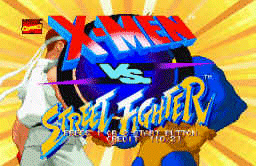
A little about the
VS. GAMES
I won't be covering the Vs. games very deeply, but here's some general info on them.

-Available for: Arcade, Saturn (import),
Playstation
-Released: 1996
-Vs Debuts: Wolverine, Cyclops, Gambit, Rogue, Sabretooth, Storm,
Magneto, Juggernaut, Ryu, Ken, Cammy, Charlie, Chun-Li, Zangief,
Dhalsim, M. Bison, Akuma (hidden), Apocalypse (boss)
-Interesting Notes: First game in the Vs series.
The very first game in the Vs series, and the one we have to thank for all the sequels (which only got better). Capcom had rights to make Marvel-related games, and had already created two fighters (X-Men: Children of the Atom and Marvel Super Heroes). Then somebody had the idea to make a crossover game along with the Street Fighter cast (the Street Fighter Alpha series was also new at the time). Thus the series was born, and tag-team fighting was never the same. Interestingly, out of the ten playable characters from X-Men: COTA, only four were used (Wolverine, Cyclops, Storm, and Sabretooth), as well as the two X-Men bosses, Juggernaut and Magneto. The remaining characters from Children of the Atom wouldn't be playable again until MvC2. A new boss was also introduced in this game, the giant Apocalypse.

-Available for: Arcade, Saturn (import),
Playstation
-Released: 1996
-Vs Debuts: Spider-Man, Captain America, Shuma-Gorath, Hulk,
Blackheart, Omega Red, Dan, Akuma, Sakura, Norimaro, Cyber Akuma
(hidden), Dark Sakura (hidden), Mecha Zangief (hidden), Mephisto
(hidden), U.S. Agent (hidden), Shadow (hidden), Anita (PSX only,
hidden)
-Interesting Notes: First game to introduce Easy Mode. Norimaro's
first appearance.
Upon the success of X-Men vs. Street Fighter, Capcom made the obvious choice of releasing a sequel using characters from their other Marvel fighter, Marvel Super Heroes. Only Psyclocke, Magneto, and Juggernaut didn't make the cut. MSHvSF was the first game to include an easy mode, which made it very simple to execute the otherwise complex button combos. Instead of rotating the control stick and pressing buttons in order, all you had to do was push two buttons at once and you had a hyper combo. This game also introduced the Japanese otaku character, Norimaro...but only in Japan. Marvel didn't like him (I guess they didn't want any goofy characters associated with their name), and told Capcom they had to take him out of the U.S. version (and likely all the other non-Asian versions as well). However, he is available on the PSX version if you use a Gameshark. Norimaro has never appeared in a game since. I'm surprised Capcom didn't try to sneak him into MvC2, considering how many less-than-realistic characters made it into that game. But they probably didn't want to upset Marvel again (although their liscense was nearly up anyway). Apocalypse returned for this game, after defeating him he was followed by the much more difficult Cyber Akuma.
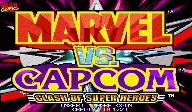
-Available for: Arcade, Playstation, Dreamcast
-Released: 1998
-Vs Debuts: Venom, War Machine, Megaman, Morrigan, Captain
Commando, Strider Hiryu, Jin, Roll (hidden), Lillith (hidden),
Hyper Venom (hidden), Orange Hulk (hidden), Gold War Machine (hidden),
Shadow Lady (hidden) Onslaught (boss)
-Interesting Notes: First game to incorporate helper characters;
first Vs game to use non-Street Fighters on the Capcom side.
After a short period of time with no new Vs games, Capcom created this edition, considered by some to be the best in the series because of it's character balance, something left to be desired in MvC2. MvC adds a third character to the tag team in the form of a "helper". When helper characters were summoned, they would jump on-screen, do an attack, and then disappear again. The inclusion of non-SF characters (most of whom were also non-fighters) on the Capcom side was a dream come true for many fans, and opened the door for a much wider and more original selection. While Morrigan and Megaman were obvious choices, Capcom also included the long-forgotten Captain Commando and Strider Hiryu, and the obscure Jin in their lineup. A new boss was also introduced, Onslaught, who was one of the most formidable Marvel bosses ever.
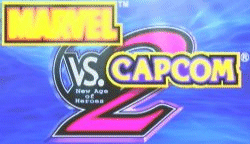
-Available for: Arcade, Dreamcast, Playstation 2
(future), X-Box (future)
-Released 2000
-Vs Debuts: (cracks knuckles) Cable, Marrow, Dr. Doom, Psylocke,
Spiral, Iceman, Sentinel, Iron Man, Silver Samurai, Colossus,
Thanos, Wolverine (bone claws), Ruby Heart, Amingo, Sonson, Tron
Bonne, Hayato, Felicia, B.B. Hood, Anakaris, Servbot, Guile,
Hayato, Jill
-Interesting Notes: largest playable character roster in any
fighting game (56 characters); first 3-on-3 tag team fighter;
Cable, Ruby Heart, Amingo, and Marrow's first appearance;
fighting game debut for much of the Capcom side; return of all
previous Marvel characters since X-Men: COTA.
While possibly the last Marvel Vs game, Capcom would not go down without a fight. Not only did they introduce four characters new to gaming and create a new version of Wolverine, they also brought back all the previous Vs characters (except Norimaro and the pallette-swap characters), added all the Marvel characters not used from X-Men: COTA and MSH (including the bosses), and introduced ten new Capcom characters, most of whom were new to fighting altogether. This game also pioneered the three-on-three tag team, and is often considered to be the craziest fighter out there. It has also become very well-known and has a huge fanbase which is rivaled by only few fighters today (including fellow Vs game, Capcom vs. SNK 2). While it appears that we may not see another Marvel game in the Vs series (at least for a while), at least Capcom saved the best for last.
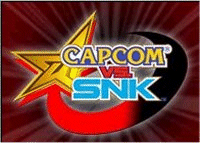
-Available for: Arcade, Dreamcast, Playstation (upcoming)
-Released: 2000
-Vs Debuts: Blanka, E. Honda, Balrog, Vega, Sagat, Evil Ryu,
Yuri, Vice, King, Benimaru, Kyo, Iori, Mai, Terry, Ryo, Kim,
Raiden, Yamazaki, Rugal, Geese, Orochi Iori, Nakoruru
-Interesting Notes: 33 characters; First non-Marvel Vs game;
first SNK crossover game (to finally settle the score with Capcom);
introduced the Groove System, with which players can select their
fighting preferences; featuring characters from Street Fighter,
Art of Fighting, King of Fighters, Fatal Fury, Darkstalkers, and
Samurai Shodown.
Capcom and SNK have had a very long rivalry going, that stretches all the way back to the days when the arcades were still big. Finally, in 2000, Capcom and SNK put aside their differences to help fans answer the question "which side would win?" In an attempt to include equal influence from both sides, Capcom created a Groove system. The Groove system allows players to pick a fighting style from either of the major sides, and tailor their teams accordingly. This game also introduced the Tier system. Characters are ranked according to a tier (1 being the lowest, and 4 being the highest). Thus, you could have as many as four Tier 1 characters, but all of them would be weak, or only one Tier 4 character, who would be strong but would lack the assistance of a second character. Players could mix and match between the four tiers, and ultimately teams would be of approximately the same strength. 33 characters were included (Capcom got the extra), many of whom were fan favorites on both sides. The SNK side had a good selection from most of SNK's major fighters (although only one Samurai Shodown character was included, to some fans dismay). The Capcom side, however, was limited almost exclusively to the Street Fighter 2 cast. In fact, only two non-SF2 characters were included (Sakura and Morrigan), and Morrigan was the only character not to come from any SF game. Capcom later tried to fix this situation somewhat in CvS2.
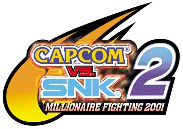
-Available for: Arcade, Dreamcast (import),
Playstation 2, Gamecube (upcoming)
-Released: 2001
-Vs Debuts: Yun, Eagle, Maki, Kyosuke, Rolento, Athena, Chang,
Haohmaru, Hibiki, Joe, Mr. Todo, Ultimate Rugal
-Interesting Notes: 44 Characters; first playable appearance of
Eagle and Mr. Todo in years; Maki's fighter debut; greater
character diversity from CvS1
The most recent game in the Vs series, CvS2 corrects some of the problems from CvS1. For one thing, the characters have been given better balance, and there are now only three Tiers instead of four. There have also been several new Grooves taken from various games added into the game. Among other things, Capcom brought back Eagle and Todo, two characters who have not had a fighting appearance in over a decade. SNK benefitted from more characters from their many series. Capcom also attempted to reconcile their side's roster a bit by including a more diverse lineup. While there are still a few noteable misses (namely Power Stone and Plasma Sword characters), Dan returned to help Sakura represent SFA, Kyosuke from Rival Schools was included, and Yun was added from the SF3 series. Maki and Rolento were also included from Final Fight, although some fans of that series would have preferred Cody or Guy. Although SNK has recently shut it's doors, Capcom has stated that this has had no affect on their potential to do more SNK-related fighters, and a third installment may come in the near future.